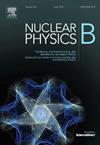分形宇宙中Barrow年龄图和New Barrow年龄图暗能量模型的参数估计:与标量场模型的对应
IF 2.8
3区 物理与天体物理
Q2 PHYSICS, PARTICLES & FIELDS
引用次数: 0
摘要
在这项工作中,我们在分形宇宙的框架内探索了巴罗年龄暗能量(BADE)和新巴罗年龄暗能量(NBADE)模型,将巴罗熵和全息原理与时间尺度作为红外(IR)截止点。通过分析共形时间和宇宙年龄作为红外截止点,我们研究了这些暗能量模型的宇宙学含义,并研究了一个充满了所提出的暗能量成分和无压物质的宇宙的演化。利用BAO和Pantheon+数据集,我们约束了模型参数,并绘制了哈勃参数和距离模量。结果与目前的观测结果一致,并与ΛCDM模型非常吻合。此外,我们提取了各种宇宙学参数,并通过平方声速分析评估了BADE和NBADE模型的稳定性。我们研究了BADE和NBADE模型的ωd - ωd '分析,以及两种模型在q−S和q−r平面上的状态检测器诊断。此外,我们还研究了能量条件,通过热力学框架对我们的模型进行了评估,并分析了它们的热稳定性。此外,在一个专门的章节中,我们研究了引入暗能量和暗物质之间的相互作用项对模型的经典和热稳定性的影响,以及它在缓解哈勃张力中的作用。然后,我们将每一个模型对应于FRW时空中DE的精质、速子、dbi -精质和k-精质标量场模型,重建这些标量场的势和动力学。最后,我们测试了每个重建模型的沼泽猜想,提供了对它们在弦理论中的理论一致性的见解。我们还通过分析慢滚参数ε和η的演变来检验模型的暴胀行为。本文章由计算机程序翻译,如有差异,请以英文原文为准。
Parameter estimation of Barrow Agegraphic and New Barrow Agegraphic Dark Energy models in fractal universe: Correspondence with scalar field models
In this work, we explore the Barrow Agegraphic Dark Energy (BADE) and New Barrow Agegraphic Dark Energy (NBADE) models within the framework of a fractal universe, incorporating Barrow entropy and the holographic principle with a time scale as the infrared (IR) cut-off. By analyzing both conformal time and the universe's age as IR cutoffs, we investigate the cosmological implications of these dark energy models and examine the evolution of a universe filled with the proposed dark energy components alongside pressureless matter. Using BAO and datasets, we constrain the model parameters and plot the Hubble parameter and distance modulus for both datasets. The results align well with current observations and demonstrate excellent agreement with the ΛCDM model. Additionally, we extract various cosmological parameters and assess the stability of the BADE and NBADE models through squared sound speed analysis. We study the analysis of the BADE and NBADE models and the statefinder diagnostic for both models in the and planes. Also, we studied the energy conditions, evaluated our models through the framework of thermodynamics, and analyzed their thermal stability. Furthermore, in a dedicated section, we investigate the impact of introducing an interaction term between dark energy and dark matter on the classical and thermal stability of the models, as well as its role in alleviating the Hubble tension. Then, we correspond each model with quintessence, tachyon, DBI-essence, and k-essence scalar field models of DE in FRW space-time to reconstruct potentials and the dynamics for these scalar fields. Finally, we test the swampland conjecture for each reconstructed model, providing insights into their theoretical consistency within string theory. We also examine the inflationary behavior of the models by analyzing the evolution of the slow-roll parameters ϵ and η.
求助全文
通过发布文献求助,成功后即可免费获取论文全文。
去求助
来源期刊

Nuclear Physics B
物理-物理:粒子与场物理
CiteScore
5.50
自引率
7.10%
发文量
302
审稿时长
1 months
期刊介绍:
Nuclear Physics B focuses on the domain of high energy physics, quantum field theory, statistical systems, and mathematical physics, and includes four main sections: high energy physics - phenomenology, high energy physics - theory, high energy physics - experiment, and quantum field theory, statistical systems, and mathematical physics. The emphasis is on original research papers (Frontiers Articles or Full Length Articles), but Review Articles are also welcome.
 求助内容:
求助内容: 应助结果提醒方式:
应助结果提醒方式:


